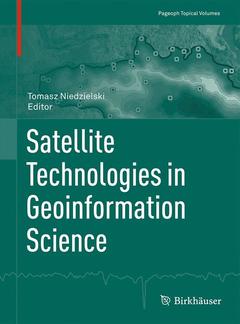Description
Satellite Technologies in Geoinformation Science, 2015
Pageoph Topical Volumes Series
Coordinator: Niedzielski Tomasz
Language: English
310 p. · 19.3x26 cm · Paperback
Description
/li>Contents
/li>Biography
/li>Comment
/li>
This topical volume covers a wide range of multidisciplinary topics, the common theme of which is processing of remotely-acquired spatial data using geo information methods. Satellite or airborne technologies and geo information itself provide powerful tools for solving numerous scientific problems in the geosciences, as they utilize geophysical principles and offer geophysicists new data and methods. Accordingly, this topical volume focuses on six key topics, presenting research applications of satellite or airborne technologies in geodynamics, geomorphology, meteorology and climatology, hydrology and limnology, oceanography and cartography. These applications make use of numerous remote sensing or observational platforms, including: Light Detection and Ranging (LiDAR), Airborne Laser Scanning (ALS), Rapid Eye, Shuttle Radar Topography Mission (SRTM), Landsat-7, Enhanced Thematic Mapper Plus (ETM+), Moderate-resolution Imaging Spectroradiometer (MODIS), Global Navigation Satellite System (GNSS), Satellite Laser Ranging (SLR), Lunar Laser Ranging (LLR), Doppler Orbitography and Radio positioning Integrated by Satellite (DORIS), as well as several altimetric and gravimetric satellite missions. The remotely-sensed data are processed using various geo information techniques, e.g. spatial interpolation and modeling, object-based image analysis, statistical and geo statistical inference and visualization.
The volume addresses the interests of scientists and practitioners whose work is related to processing remote sensing data using geoinformation methods. Postgraduate students of geography, geodesy, cartography and geophysics ? as well as students of the broader geosciences ? will also find the book to be a valuable resource, as it brings together numerous satellite and airborne technologies with geospatial processing methods, presents case studies and examines most applications in the context of basic geophysical principles.
Brings together satellite and airborne technologies with geospatial processing methods
Presents case studies examining most applications in the context of basic geophysical principles
Addresses scientists and practitioners in the field of processing remote sensing data using geo information methods
Valuable resource for postgraduate students of geography, geodesy, cartography and geophysics
These books may interest you

Basics of Geomatics 232.09 €



